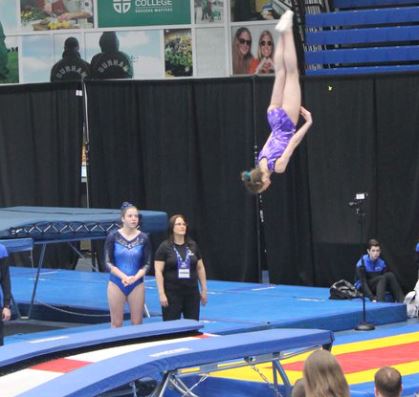Winter 2026 session
| No Gym Days |
First Class Days |
Last Class Days |
|
Dec 22, 2025 - Jan 2, 2026 - Christmas Break
|
Tuesday - Dec 2 Thursday - Dec 4 Saturday - Dec 6 Sunday - Dec 7 |
Tuesday - Feb 17Thursday - Feb 19Saturday - Feb 14Sunday - Feb 15 |
|
Winter 2026 Session March Break Camp Spring 2026 Session |
Registration will open Nov. 17, 2025Registration will open Feb 2, 2026 Registration will open Feb 23, 2026 |
|
Competitive Trampoline
Trampoline
Trampoline, an Olympic discipline, symbolizes freedom, flying, and space. Multiple somersaults and twists are performed at a height of 8 m and require precise technique and perfect body control. The trampoline is also used as a basic training device for all sports that contain acrobatic elements.
A typical competition routine on the trampoline is characterized by high, continuous rhythmic feet to feet, to back, front or seat rotational jumping elements, without hesitation or intermediate straight bounces between two elements.
In a synchronized competition, a pair of gymnasts can consist of two women or two men. Pairs must do the same element at the same time and must start facing the same direction.
A typical trampoline competition is made up of three routines/rounds: compulsory (a combination of free and compulsory elements), voluntary (free elements of the gymnast’s choosing) and the final voluntary round. Each routine is made up of 10 skills and must start and finish on the feet.

Double Mini Trampoline
Double Mini Trampoline developed from the common mini-tramp, but allows for a more acrobatic performance. After a take-off, the competitors perform one exercise on the mini-trampoline, followed by another routine on the landing mat. High level gymnasts execute double and triple somersaults with twists.
The DMT is like two mini tramps that have been joined in the middle. The first section of the apparatus is set at a slight angle and called the mount. From the mount, skills are performed onto the second section of the apparatus. This second section is called the spotter and is where skills can be performed back onto the tramp bed or as a dismount onto the landing mat.
Double Mini Trampoline can be likened to a combination of Athletics, Trampolining and Gymnastics. Competitors sprint down a carpeted track and hurdle onto the apparatus before performing double and triple somersaults with the same precision required on a trampoline. The only difference is that gymnasts have to land on a trampoline bed less than a quarter the size of a trampoline, before performing a dismount on to a landing mat.
In DMT competitions there are four passes, two in the preliminary round and then two in the final round. Each pass consists of one skill performed as either a mount or a spotter, followed by a dismount skill making two skills per pass.
Power Tumbling
Tumbling is characterized by continuous speedy, complex, rhythmic hands-to-feet, feet-to-hands acrobatic elements lasting around 6 seconds. This work is performed on a 25 m-long dynamic track. Tumbling is a highly spectacular sport, in which a perfect combination of speed and rhythm in somersaulting and twisting movements are required.
In tumbling, a gymnast performs a tumbling pass which sees the gymnast gain speed and power by running along a track and performing a series of somersaults and twists. World-class tumblers perform no less than two double somersaults in one run, the best of them three, with twisting elements in addition.
A typical tumbling competition will include the gymnast completing three tumbling passes. The first is called a Straight Pass (composed of somersaults), the second is called the Twisting Pass (twists) with the third and Final Pass (composed of both somersaults and twists.
